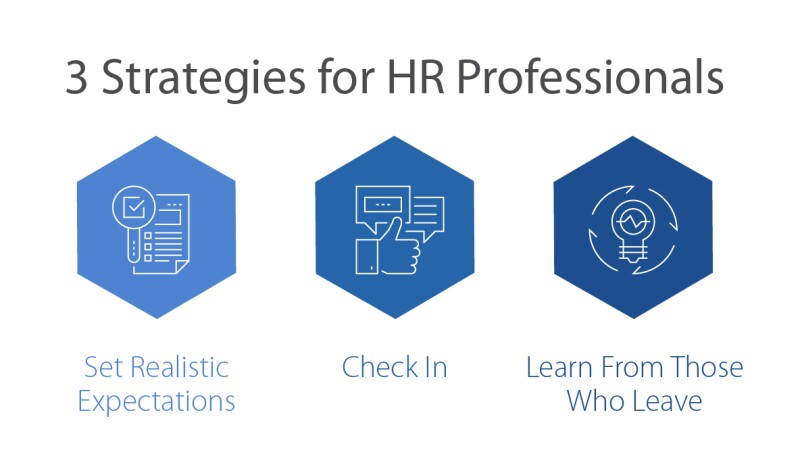3 Strategies for HR Professionals
It can be a real challenge to land a job, especially one within a person’s desired field that offers a competitive salary and good benefits. But on the flip side—and perhaps somewhat surprisingly, considering the effort involved in job hunting—it’s an equally daunting task for Human Resources (HR) professionals to retain talented employees in their companies and prevent turnover.1
As more millennials fill the country’s open positions, the need for effective strategies to reduce employee turnover is rapidly increasing. HR professionals have to keep in mind that 60 percent of this young demographic group say they’re open to considering a new job, and over 20 percent have changed jobs within the last year.2 Of course, millennials aren’t the only population in the workforce, but they now officially make up the largest percentage, with over 53 million employed.3
With a generation that’s so used to the idea of job mobility, how do HR professionals improve retention rates? Below, we’ve provided three strategies for reducing employee turnover to help those in HR keep the people they worked so hard to hire.

1: Set Realistic Career Path Expectations
When applying and interviewing for a position, candidates have a lot to take in. Even though they’re given the opportunity to ask all relevant questions about the job before accepting it, they may not always have a full grasp of some of the crucial details before beginning work. For example, questions surrounding promotion opportunities—timelines and possible pay increases—aren’t always covered within job interviews.
Whether a subject is not brought up because an applicant is afraid it will negatively affect his/her chances of getting the job, or because the hiring manager didn’t find it important, the truth is that these are important issues to employees, and discussing them from the beginning can go a long way toward setting clear expectations and keeping an employee. In fact, 32 percent of employees cite lack of advancement potential as their reason for leaving their job.4
What does this all mean? It’s simple: if people think there’s no possibility of advancement, they’ll leave and try to find a job where they can advance. To help avoid losing employees for this reason, HR professionals may want to consider addressing this subject with the hiring manager before the interview process. That way, realistic expectations can be established on all sides.
2: Check In
Once an employee has been hired, it’s important to check in with them from time to time to see how they’re adjusting to their new work environment. Even employees who have worked in an organization for several years may appreciate an HR professional reaching out to them now and then to see how everything’s going. Anything that can be done to keep lines of communication as open as possible for those employed can go a long way in helping them feel supported and able to handle work-related obstacles as they come up—without feeling the need to look for jobs elsewhere.
3: Learn From Those Who Leave
When employees do leave a company, HR can use their exit as an opportunity for growth. By conducting an exit interview, HR professionals can learn the reasons behind the employee’s departure. Since the employee is leaving, most likely to a new position, he/she is more likely to be completely candid in their critique of the company, creating a unique moment for honest feedback.5 HR must try to receive this information in good faith and use it to inform the work environment moving forward, so that they don’t lose more employees for the same reasons.
The Cost of a Loss
Employee turnover has a high cost for companies, both financially and culturally. The hiring process is long and requires valuable work hours from a number of high-level employees. Plus, constant turnover isn’t good for the company culture, or its image. With all this in mind, it’s of vital importance for HR professionals to work diligently to try and keep their employees happy in their positions. While it’s unrealistic to try to keep everyone, taking a strategic approach to turnover reduction sooner than later could go a long way toward saving time and money while improving overall employee satisfaction.
Interested in learning more about the ins and outs of employee retention? Check out the online Master of Jurisprudence in Labor & Employment Law (MJ-LEL) from Tulane University Law School.
- Retrieved on March 26, 2018, from ncsl.org/research/labor-and-employment/national-employment-monthly-update.aspx
- Retrieved on March 26, 2018, from news.gallup.com/businessjournal/191459/millennials-job-hopping-generation.aspx
- Retrieved on March 26, 2018, from time.com/3854518/millennials-labor-force/
- Retrieved on March 26, 2018, from inc.com/marcel-schwantes/why-are-your-employees-quitting-a-study-says-it-comes-down-to-any-of-these-6-reasons.html
- Retrieved on March 26, 2018, from shrm.org/hr-today/news/hr-magazine/pages/0804agenda_empstaffing.aspx

